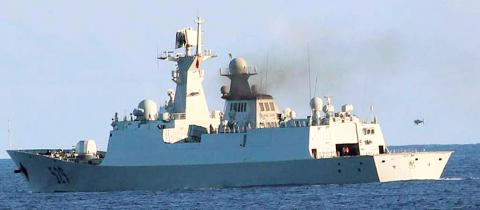Pictures released earlier this week by the Japan Maritime Self-Defense Force (JMSDF) showing mysterious unmanned aerial vehicles (UAV) hovering above and parked on the rear landing deck of a Chinese frigate at sea have left defense analysts scratching their heads.
The pictures, first published by Japanese media on Wednesday, were taken while three People’s Liberation Army Navy vessels — the Type 054A missile frigates Zhoushan and Xuzhou, and the electronic reconnaissance and missile tracking Beijixing — conducted exercises in the West Pacific, about 700km off Japan’s Okinotori.
A Japanese surveillance aircraft spotted the vessels on April 29 as they crossed from the East China Sea into the strait of Osumi, the first such crossing by PLAN vessels in nine years. The ships were again spotted on their return journey on Monday.

Photo courtesy of the Japan Maritime Self Defense Force
Aside from the rare crossing in a channel usually used by the US 7th Fleet, what mystified defense enthusiasts were two pictures released by the JMSDF, one showing three unmanned helicopters on the platform of the Zhoushan and another showing a similar type of UAV hovering above the vessel.
The People’s Liberation Army has a longstanding interest in UAV technology, and several civilian and military firms, including Aviation Industry Corp of China (AVIC), have been working on a variety of models. However, China has yet to confirm the successful development of an unmanned helicopter that is heavy enough and capable of vertical takeoff and landing (VTOL) at sea, where runways are in short supply.
Very few models worldwide have demonstrated the capability so far. One of them, the Camcopter S-100s, built by Austrian firm Schiebel Corp, held a successful trial at sea last month on board an Italian naval ship.
According to analysts, the UAVs seen on the Zhoushan bear a striking resemblance to the S-100. The S-100 was showcased at the Fourth China International Exhibition on Police and Anti-Terrorism Technology and Equipment Exhibition held in Beijing in April last year, and defense-related Chinese Web sites have paid close attention to the device.
Rumors have circulated in defense circles that China may have placed orders for several S-100s. Although the EU has an arms embargo on China, the rules appear to have been relaxed in recent years, limiting exports to purely defensive platforms.
Foreign clients of the S-100 include Germany, the United Arab Emirates, Libya and South Korea, which experienced a crash in Incheon on May 11, killing one person. Pakistan has also expressed interest in acquiring the UAV.
Another possibility raised by some experts is that Chinese firms reverse-engineered the S-100, as they have often done with foreign technology.
One model, China’s Sunward Tech Star-lite SVU200, which conducted its maiden flight on land recently, looks very similar to the S-100. However, Greg Waldron of Flight Global, who attended the Beijing Air Show in September, where the SVU200 was showcased, told the Taipei Times the manufacturer had not mentioned sea capabilities for the aircraft.
Unmanned vehicles can serve a number of military purposes, including electro-optic surveillance, reconnaissance, target acquisition radar and transmission relay.
Such capabilities substantially increase a navy’s ability to monitor and control its surroundings. Larger models can also carry a variety of missiles.

SECURITY: As China is ‘reshaping’ Hong Kong’s population, Taiwan must raise the eligibility threshold for applications from Hong Kongers, Chiu Chui-cheng said When Hong Kong and Macau citizens apply for residency in Taiwan, it would be under a new category that includes a “national security observation period,” Mainland Affairs Council (MAC) Minister Chiu Chui-cheng (邱垂正) said yesterday. President William Lai (賴清德) on March 13 announced 17 strategies to counter China’s aggression toward Taiwan, including incorporating national security considerations into the review process for residency applications from Hong Kong and Macau citizens. The situation in Hong Kong is constantly changing, Chiu said to media yesterday on the sidelines of the Taipei Technology Run hosted by the Taipei Neihu Technology Park Development Association. With

CARROT AND STICK: While unrelenting in its military threats, China attracted nearly 40,000 Taiwanese to over 400 business events last year Nearly 40,000 Taiwanese last year joined industry events in China, such as conferences and trade fairs, supported by the Chinese government, a study showed yesterday, as Beijing ramps up a charm offensive toward Taipei alongside military pressure. China has long taken a carrot-and-stick approach to Taiwan, threatening it with the prospect of military action while reaching out to those it believes are amenable to Beijing’s point of view. Taiwanese security officials are wary of what they see as Beijing’s influence campaigns to sway public opinion after Taipei and Beijing gradually resumed travel links halted by the COVID-19 pandemic, but the scale of

A US Marine Corps regiment equipped with Naval Strike Missiles (NSM) is set to participate in the upcoming Balikatan 25 exercise in the Luzon Strait, marking the system’s first-ever deployment in the Philippines. US and Philippine officials have separately confirmed that the Navy Marine Expeditionary Ship Interdiction System (NMESIS) — the mobile launch platform for the Naval Strike Missile — would take part in the joint exercise. The missiles are being deployed to “a strategic first island chain chokepoint” in the waters between Taiwan proper and the Philippines, US-based Naval News reported. “The Luzon Strait and Bashi Channel represent a critical access

Pope Francis is be laid to rest on Saturday after lying in state for three days in St Peter’s Basilica, where the faithful are expected to flock to pay their respects to history’s first Latin American pontiff. The cardinals met yesterday in the Vatican’s synod hall to chart the next steps before a conclave begins to choose Francis’ successor, as condolences poured in from around the world. According to current norms, the conclave must begin between May 5 and 10. The cardinals set the funeral for Saturday at 10am in St Peter’s Square, to be celebrated by the dean of the College